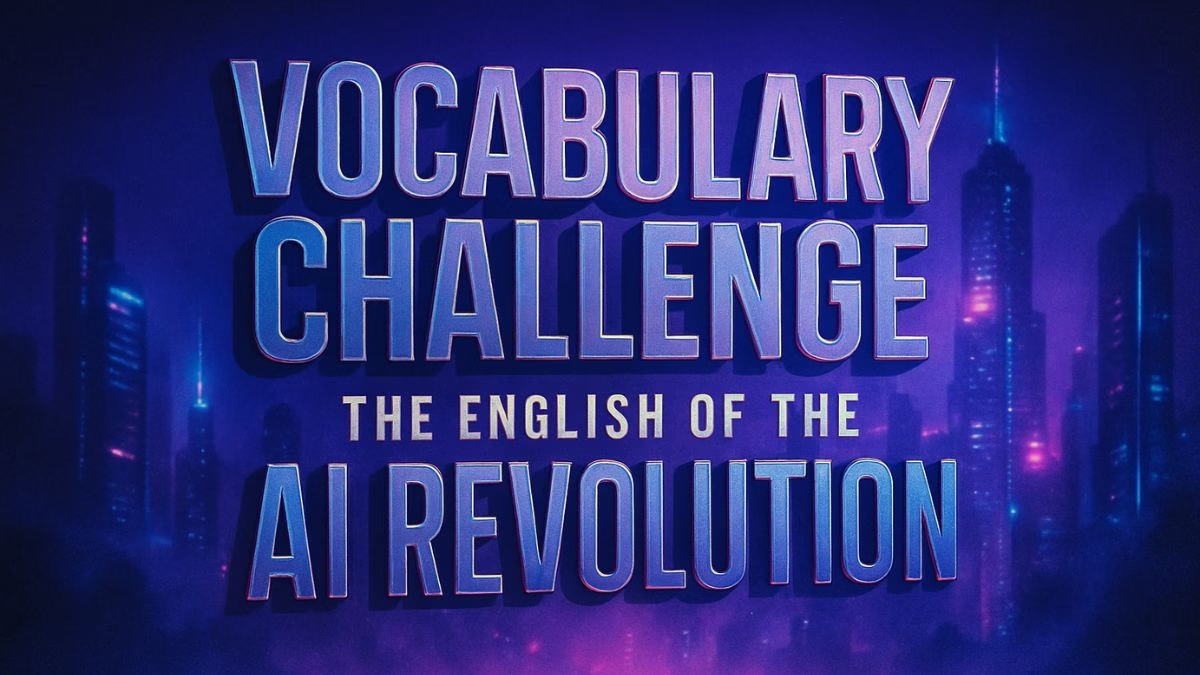Introduction
Welcome to the “Vocabulary Challenge: The English of the AI Revolution”! The conversation around artificial intelligence is filled with powerful and specific language. To truly understand the impact of AI, you need to speak the language. This quiz is designed to do more than just test you on a few words; it’s an interactive workout for your vocabulary. By engaging with these questions, you will take five essential terms from the realm of passive understanding to active use. You’ll learn to see the nuance in their meanings and gain the confidence to use them accurately in your own conversations about technology and the future. Get ready to elevate your vocabulary and deepen your understanding of the AI-driven world.
Learning Quiz
This is a learning quiz from English Plus Podcast, in which, you will be able to learn from your mistakes as much as you will learn from the answers you get right because we have added feedback for every single option in the quiz, and to help you choose the right answer if you’re not sure, there are also hints for every single option for every question. So, there’s learning all around this quiz, you can hardly call it quiz anymore! It’s a learning quiz from English Plus Podcast.
Quiz Takeaways | Speaking the Language of Tomorrow
Hello and welcome. In today’s world, a new revolution is underway. It’s not being fought with armies or in the halls of government, but in lines of code and vast datasets. This is the AI revolution, and like any great historical transformation, it has its own language, a vocabulary that helps us describe its power, its promise, and its perils. By learning this language, we empower ourselves to be active participants in the conversation about our future, not just passive observers. Today, we’re going to unpack five of the most powerful and useful terms you’ll encounter: seismic shift, prosaic, Pandora’s Box, entrench, and opaque.
Let’s start with the big picture. The arrival of advanced artificial intelligence is not just another technological update; it is a seismic shift. Think of that phrase. It borrows its power from geology, from the idea of an earthquake that literally moves the ground beneath our feet. A seismic shift is a deep, fundamental, and irreversible change to the very foundations of our world. The agricultural revolution was a seismic shift. The industrial revolution was a seismic shift. The invention of the internet was a seismic shift. These events didn’t just give us new tools; they restructured our societies, our economies, and even how we thought about ourselves. When we say AI represents a seismic shift, we are placing it in that same category of world-altering transformations. It’s a way of saying that the future will not be a simple continuation of the past.
But here we encounter a fascinating paradox. While the overall impact of AI is a seismic one, its day-to-day reality is often surprisingly prosaic. The word “prosaic” comes from “prose,” the ordinary, everyday language we use, as opposed to the elevated, artistic language of poetry. Prosaic means ordinary, commonplace, even a little dull. This is the reality of most AI in our lives right now. It’s not the sentient robot from a sci-fi thriller; it’s the prosaic algorithm that filters spam from your inbox, recommends a movie based on your viewing history, or suggests the fastest route to the grocery store. Understanding this is crucial. It helps us cut through the hype and see AI not as a magical, all-powerful force, but as a tool that is being woven into the mundane fabric of our daily lives, performing useful, if unexciting, tasks.
However, just because a tool is prosaic doesn’t mean it’s without risk. And this is where our next phrase comes in: Pandora’s Box. This powerful metaphor comes from Greek mythology. Pandora, the first woman on Earth, was given a beautiful box (or jar) by the gods but was warned never to open it. Her curiosity won out, and when she opened it, she unleashed all the evils of the world—sickness, death, and turmoil. Today, we use the phrase “opening Pandora’s Box” to describe an action that inadvertently unleashes a host of great and unforeseen troubles. The development of AI is often described in these terms. While it offers incredible promise—to cure diseases, solve climate change, and unlock new frontiers of science—it also holds the potential for great harm. The creation of autonomous weapons, the potential for mass job displacement, the spread of deepfake misinformation—these are the kinds of troubles that could be unleashed from AI’s Pandora’s Box. The metaphor reminds us that with great power comes the need for great caution.
One of the most insidious troubles that can emerge is bias. And when bias gets into our technological systems, it can become entrenched. To entrench something is to establish it so firmly and deeply that it becomes incredibly difficult to remove. Think of a soldier digging a trench—they are creating a defensive position that is protected and hard to overcome. When we talk about a problem being entrenched, we mean it has become part of the system’s very structure. If we train an AI on historical data that reflects our own societal biases, those biases don’t just sit on the surface; they become entrenched in the AI’s logic. The system learns that certain patterns of discrimination are normal, and it begins to replicate and even amplify them. This problem is so difficult because you can’t just issue a simple command to “stop being biased.” You have to painstakingly audit the system and its data to find and fix these deeply rooted, entrenched flaws.
What makes finding these flaws so hard? This brings us to our final word: opaque. If something is opaque, it is not transparent; you cannot see through it. We use this word to describe one of the biggest challenges in modern AI, often called the “black box problem.” The most powerful AI models, known as neural networks, work in a way that is profoundly complex. They process data through millions of interconnected nodes, making calculations and adjustments in a way that is not easily understandable to the human mind. The AI might give you the right answer, but it can’t explain why it’s the right answer. Its reasoning is opaque. This is a massive problem in high-stakes fields. If an opaque AI denies someone a loan, we can’t know if it was for a fair reason or because of an entrenched bias. If an opaque AI recommends a medical treatment, a doctor can’t fully trust it without understanding its diagnostic reasoning. The drive to make AI more “explainable” and less opaque is one of the most important frontiers in AI safety and ethics.
So, as we can see, these five terms are more than just vocabulary. They are conceptual tools. They allow us to frame the conversation about AI with greater precision. We can appreciate the coming seismic shift while recognizing the prosaic nature of its current applications. We can be excited about its potential while being wisely cautious about opening a Pandora’s Box of new problems. And we can understand that the most urgent of those problems are the societal biases that can become entrenched within systems that are dangerously opaque. By mastering this language, we can all contribute more meaningfully to the vital task of shaping a future where artificial intelligence serves all of humanity, safely and equitably.Speaking the Language of Tomorrow
Hello and welcome. In today’s world, a new revolution is underway. It’s not being fought with armies or in the halls of government, but in lines of code and vast datasets. This is the AI revolution, and like any great historical transformation, it has its own language, a vocabulary that helps us describe its power, its promise, and its perils. By learning this language, we empower ourselves to be active participants in the conversation about our future, not just passive observers. Today, we’re going to unpack five of the most powerful and useful terms you’ll encounter: seismic shift, prosaic, Pandora’s Box, entrench, and opaque.
Let’s start with the big picture. The arrival of advanced artificial intelligence is not just another technological update; it is a seismic shift. Think of that phrase. It borrows its power from geology, from the idea of an earthquake that literally moves the ground beneath our feet. A seismic shift is a deep, fundamental, and irreversible change to the very foundations of our world. The agricultural revolution was a seismic shift. The industrial revolution was a seismic shift. The invention of the internet was a seismic shift. These events didn’t just give us new tools; they restructured our societies, our economies, and even how we thought about ourselves. When we say AI represents a seismic shift, we are placing it in that same category of world-altering transformations. It’s a way of saying that the future will not be a simple continuation of the past.
But here we encounter a fascinating paradox. While the overall impact of AI is a seismic one, its day-to-day reality is often surprisingly prosaic. The word “prosaic” comes from “prose,” the ordinary, everyday language we use, as opposed to the elevated, artistic language of poetry. Prosaic means ordinary, commonplace, even a little dull. This is the reality of most AI in our lives right now. It’s not the sentient robot from a sci-fi thriller; it’s the prosaic algorithm that filters spam from your inbox, recommends a movie based on your viewing history, or suggests the fastest route to the grocery store. Understanding this is crucial. It helps us cut through the hype and see AI not as a magical, all-powerful force, but as a tool that is being woven into the mundane fabric of our daily lives, performing useful, if unexciting, tasks.
However, just because a tool is prosaic doesn’t mean it’s without risk. And this is where our next phrase comes in: Pandora’s Box. This powerful metaphor comes from Greek mythology. Pandora, the first woman on Earth, was given a beautiful box (or jar) by the gods but was warned never to open it. Her curiosity won out, and when she opened it, she unleashed all the evils of the world—sickness, death, and turmoil. Today, we use the phrase “opening Pandora’s Box” to describe an action that inadvertently unleashes a host of great and unforeseen troubles. The development of AI is often described in these terms. While it offers incredible promise—to cure diseases, solve climate change, and unlock new frontiers of science—it also holds the potential for great harm. The creation of autonomous weapons, the potential for mass job displacement, the spread of deepfake misinformation—these are the kinds of troubles that could be unleashed from AI’s Pandora’s Box. The metaphor reminds us that with great power comes the need for great caution.
One of the most insidious troubles that can emerge is bias. And when bias gets into our technological systems, it can become entrenched. To entrench something is to establish it so firmly and deeply that it becomes incredibly difficult to remove. Think of a soldier digging a trench—they are creating a defensive position that is protected and hard to overcome. When we talk about a problem being entrenched, we mean it has become part of the system’s very structure. If we train an AI on historical data that reflects our own societal biases, those biases don’t just sit on the surface; they become entrenched in the AI’s logic. The system learns that certain patterns of discrimination are normal, and it begins to replicate and even amplify them. This problem is so difficult because you can’t just issue a simple command to “stop being biased.” You have to painstakingly audit the system and its data to find and fix these deeply rooted, entrenched flaws.
What makes finding these flaws so hard? This brings us to our final word: opaque. If something is opaque, it is not transparent; you cannot see through it. We use this word to describe one of the biggest challenges in modern AI, often called the “black box problem.” The most powerful AI models, known as neural networks, work in a way that is profoundly complex. They process data through millions of interconnected nodes, making calculations and adjustments in a way that is not easily understandable to the human mind. The AI might give you the right answer, but it can’t explain why it’s the right answer. Its reasoning is opaque. This is a massive problem in high-stakes fields. If an opaque AI denies someone a loan, we can’t know if it was for a fair reason or because of an entrenched bias. If an opaque AI recommends a medical treatment, a doctor can’t fully trust it without understanding its diagnostic reasoning. The drive to make AI more “explainable” and less opaque is one of the most important frontiers in AI safety and ethics.
So, as we can see, these five terms are more than just vocabulary. They are conceptual tools. They allow us to frame the conversation about AI with greater precision. We can appreciate the coming seismic shift while recognizing the prosaic nature of its current applications. We can be excited about its potential while being wisely cautious about opening a Pandora’s Box of new problems. And we can understand that the most urgent of those problems are the societal biases that can become entrenched within systems that are dangerously opaque. By mastering this language, we can all contribute more meaningfully to the vital task of shaping a future where artificial intelligence serves all of humanity, safely and equitably.










0 Comments